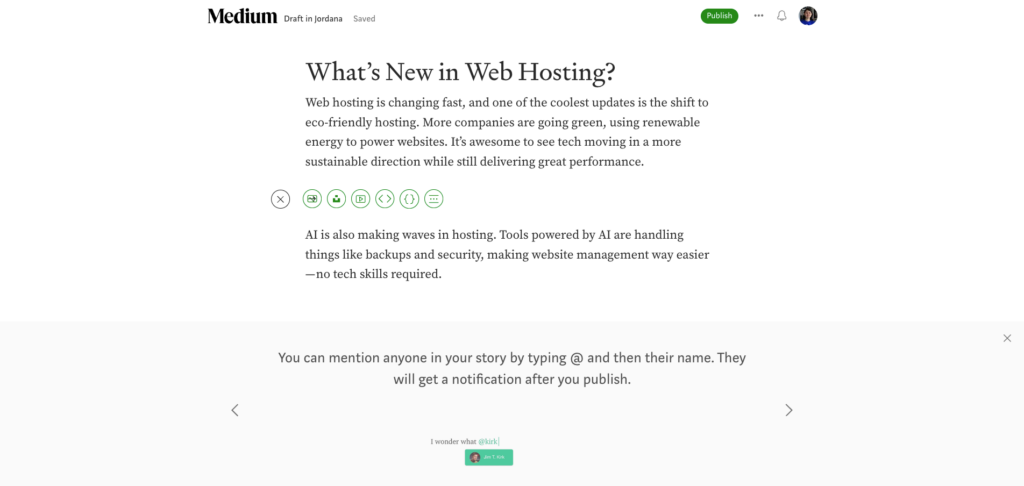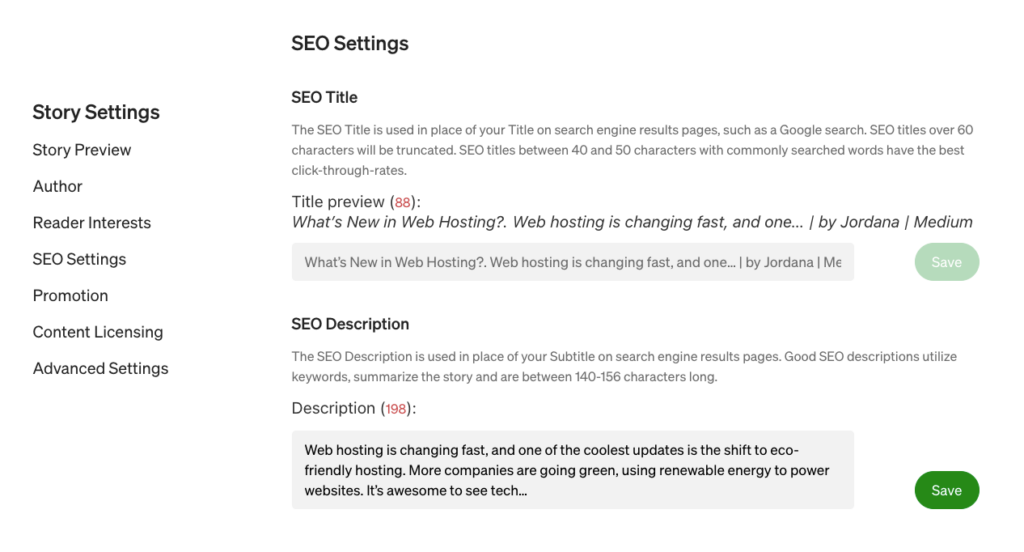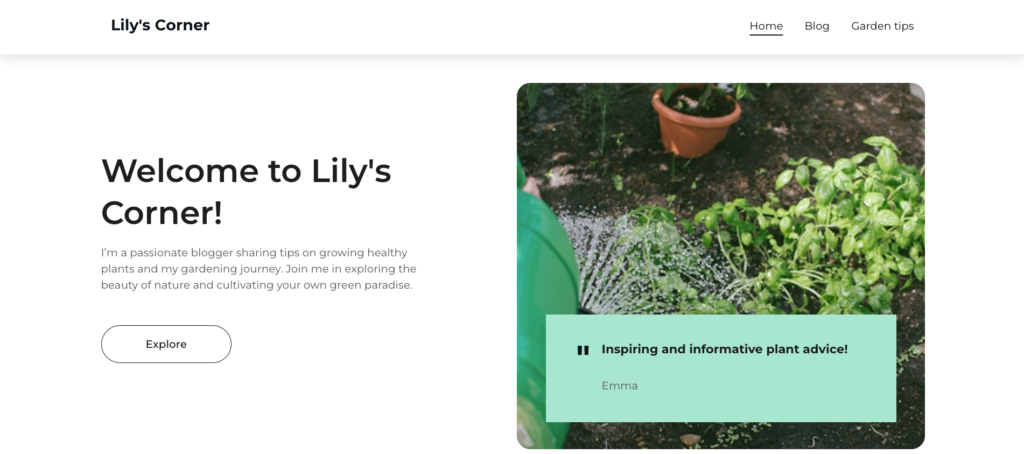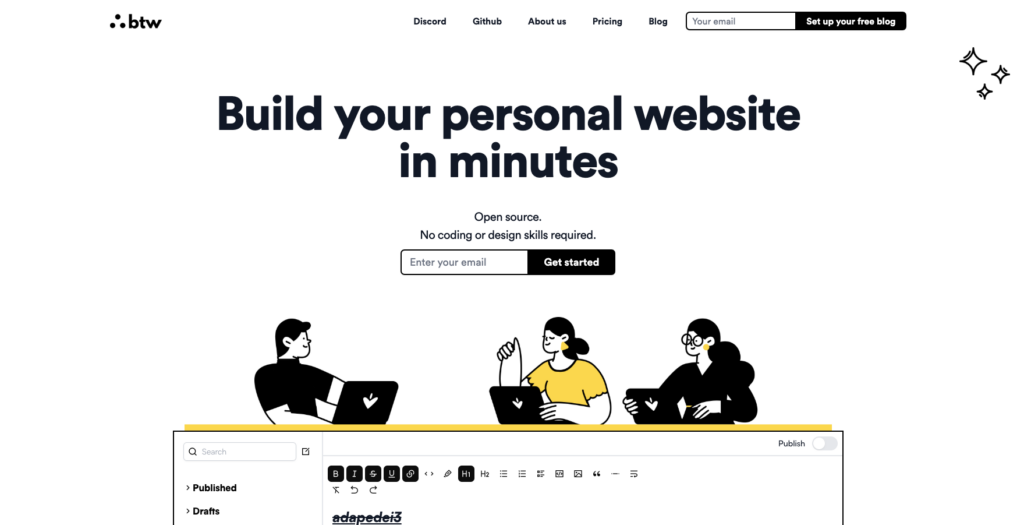I tested the best blogging platforms: Here are my top 6 picks

Blogging involves more than just ideas or soft skills ‒ it’s also about using the right tools. The platform you choose can boost your productivity, shape your content exactly how you want, and help you reach the right audience. So yes, finding the best blogging platform matters.
As someone who loves writing and has spent over five years in the IT world, I’ve tested and compared numerous blogging platforms, from budget-friendly options to premium ones. In this article, I’m sharing my personal favorites and why I think they’re worth your time.
I’ve tried to include platforms for all kinds of bloggers. Whether you’re blogging to earn money or simply to share your thoughts, there’s something here for you.
What makes a good blogging platform?
Before diving into my review, let’s clarify one thing ‒ there’s no one-size-fits-all blogging platform. Each one has its own strengths, so start your blog with the platform that best fits your needs.
That being said, there are several key factors I keep in mind when narrowing down my options:
- Ease of use. I want a platform that’s quick to master. A user-friendly interface and intuitive tools streamline the blogging process, letting me focus more on writing and less on navigating the platform.
- Customization options. A blog is often the owner’s creative expression, so it’s important that I can make it look and feel the way I want. If you’re not tech-savvy, make sure you can do this without coding.
- SEO capabilities. Using a platform with tools that help my blog rank in search engines reduces the work needed to increase its visibility.
- Content management tools. As I grow my blog, having a solid content management system (CMS) helps improve my productivity. Whether it’s organizing posts, scheduling updates, or managing media, I need to keep everything streamlined and easy to access.
- Scalability. A good blogging platform should grow with me. It should be able to handle more traffic, content, and features without slowing down or needing a major upgrade.
- Mobile optimization. Most people now browse blogs on their phones, so mobile adaptability is a must-have. I want my readers to have a smooth experience whether they’re on desktop or mobile.
- Value for money. Whether it’s affordable pricing or free useful features, I want to make sure I’m getting my money’s worth.
The blogging platforms that made the cut
The following blogging platforms go in no particular order, so don’t take this as a ranking.
1. WordPress.org

Pros
- Highly scalable.
- Tons of customization options.
- Advanced SEO.
Cons
- Many features require plugins.
- Costs can add up.
- Self-maintained.
Setting up WordPress used to be a hassle, and I agree. You had to sort out hosting, get a domain name, install WordPress, and configure plugins and themes before you could even start writing.
Thankfully, things are much simpler now. Most WordPress hosting providers offer a one-click installer, allowing you to set everything up right from your hosting control panel.
With Hostinger’s Managed WordPress hosting, you can do even more during onboarding ‒ install plugins, pick a theme, and add posts or images tailored to your niche. Or, try the WordPress AI website builder to get your site up and running quickly.
Check out Pet Lovers Chronicle, a blog I built in less than five minutes using the AI Website Builder for WordPress. Sure, it still needs a few tweaks and personal touches, but the pre-built layouts made everything so much faster.

The WordPress admin dashboard is straightforward, but navigating the tools and features might take time. If you don’t know where to start, head to the homepage for handy pointers.

Since WordPress was originally designed for blogging, it’s packed with all the tools to start. The block-based editor lets you add, move around, and customize elements without coding. You can even save block patterns to keep your blog’s design consistent.
If you like being organized like me, you’ll love the platform’s categories and tags and how easily they make structuring your content. Plus, you can moderate comments to keep your readers engaged while keeping spam out of the picture.

A huge plus point is that WordPress is super easy to grow with. You could start your blog to share your thoughts. As your community gets bigger, add memberships for exclusive content or even set up an online store to sell merchandise or your own book. There are plugins for pretty much everything, and WordPress has tons to choose from.
Search engine optimization (SEO) is also easy with built-in tools and plugins. WordPress automatically generates XML sitemaps to help search engines crawl and index your site. You can customize each post’s meta title and description to increase your ranking chances.
The downside of having so many plugins to choose from is that the costs can add up, and your blog might slow down if you go overboard. Many of them offer free versions, but they often lack advanced features you’ll probably want as your blog and goals grow.
Not to be confused with WordPress.com, this version is self-hosted, meaning you manage your own website. This includes updating your WordPress core software, plugins, and themes and periodically backing up your blog. It’s not hard, but I get why some people might not want the extra responsibility, especially if you’re just starting out.
Pricing breakdown
WordPress itself is free, so you only need to pay for web hosting and a domain name to start. Hosting prices vary by provider, but you can usually save a lot by going for a long-term plan.
To give you an idea, Hostinger’s managed WordPress and domains hosting packages start at ₹149.00/month for a 48-month term. All annual hosting plans include a free domain name for the first year.
Down the road, you might want to invest in premium plugins and themes, which also range in price depending on their features. But honestly, unless you’re planning to make blogging your full-time gig right away, you can keep it budget-friendly and scale up your spending as your blog grows.
Why I recommend WordPress
WordPress is a versatile platform that strikes the perfect balance between flexibility and affordability. If you’re about to kick off your blogging journey and want to keep costs low, WordPress is a solid choice. With tons of free features, you can experiment without the financial risk.
By having complete control over your blog, you can shape and scale it however you want. Unlike other platforms, you own your content, decide on monetization methods, and can switch hosting providers whenever you like.
Plus, thanks to the massive WordPress community, it’s super easy to find resources for navigating the platform. Check out this article on using WordPress to learn how it works and whether it’s the right fit for you.

2. Medium

Pros
- Quick setup and easy to use.
- Built-in monetization options.
- Has an established readership.
Cons
- Lacks personalization features.
- Basic blogging and SEO tools.
- Limited monetization options.
If you love getting inspired and motivated in a creative space, Medium could be a great fit for you. It’s like a social network where readers can follow their favorite writers, and writers can build a following by sharing niche content.
It’s also great for those who want to focus on writing and don’t want to deal with technical stuff. Just sign up for an account using your active email address or social account, and you’re all set.
After creating your account, the platform will take you to the homepage displaying published articles, staff picks, and suggestions for people to follow. This is where you can find blog post ideas from other writers and curate the topics.

The interface looks pretty much like social media, so you should get used to it in no time. Clicking the Write button at the top right corner of the homepage will open the post editor.
If you’ve used any text editor before, you’ll feel right at home with this one. To change text styles, just highlight a word or phrase, and a toolbar with options will pop up. Want to add something? Hit the plus (+) button or paste a URL to embed Medium articles or other content.
And if you’re new to it, there’s a handy slideshow tutorial at the bottom of the editor.

Medium keeps things simple, so don’t expect any fancy features beyond basic formatting. Relying on the platform’s ecosystem means you can’t control how your articles appear, making it hard to stand out.
Another thing that bugs me is how hidden the SEO settings are, since they’re outside the editor. Even then, all you can change is the post’s meta title and description. While Medium does some automatic optimization, it’s a letdown if you care about advanced SEO features like custom URLs or schema markup.

Medium has built-in analytics to help you track how your posts and overall account are performing. However, just like the editor, they lack advanced features and third-party integration for deeper insights.
If you want to make money blogging, Medium offers two monetization methods ‒ enabling tipping and applying to the Partner Program. The latter is the more popular option, allowing writers to earn a share of Medium membership fees by paywalling their posts.

Revenue on Medium typically starts at $10-20 per 1,000 views, but the payment system is more complex than just counting views. Payouts depend on how paying users (members) allocate their reading time and engagement, meaning the value of your views can vary significantly.
Since Medium isn’t adding Google AdSense anytime soon, the best way to increase your earnings is to focus on writing high-quality posts that keep readers engaged and coming back for more.
Pricing breakdown
You can sign up for Medium and start writing for free. But if you want to join the Partner Program and earn from your content, you’ll need to get a $5/month membership. Plus, being a member lets you connect a custom domain to your profile, which is crucial for building your personal brand.
Why I recommend Medium
Medium is perfect for writers and content creators who just want to focus on what they love ‒ writing. Its social-media-like feel makes blogging less intimidating, especially for those who aren’t super tech-savvy, so it’s a great way to get started.
That said, if you’re looking to make money right away, it might take a bit of time and effort to turn Medium into a revenue stream. In that case, you might want to check out other platforms with more monetization options and SEO capabilities.
3. Ghost

Pros
- Membership and newsletter capabilities.
- Built-in SEO tools.
- Uses integrations instead of plugins, making it lightweight.
Cons
- The open-source version isn’t beginner-friendly.
- Advanced customization requires coding.
- Smaller community.
If WordPress is like a full toolbox, Ghost is more like a sleek, minimalist pen. It’s perfect for content-focused sites, keeping things simple with built-in blogging and monetization features.
You can self-host Ghost with the open-source version or go with Ghost Pro, their managed service that handles updates and performance. The hosted option even includes pre-configured integrations, so there’s no need to mess with individual setups.

After creating an account, you’ll enter the dashboard area where you can manage content, customize site design, and organize tags. The dark mode completes the minimalist layout, emphasizing how the platform is all about making writing easy, readable, and free from distractions.

The post editor maintains the same clean look, with settings like WordPress. As someone used to the accessible advanced SEO settings in WordPress, I appreciate that Ghost includes them right in the editor, too. You can even create social cards while writing ‒ no extra tool needed.
Adding elements and changing text styles feels more like Medium since it doesn’t have the drag-and-drop function you get with the WordPress block editor. Overall, beginners should pick it up in no time.
Ghost lets you monetize your content with built-in tools for memberships and subscriptions, using Stripe as the native payment provider. You can also share a post as a newsletter during publishing, keeping your audience in the loop and making it easier to turn readers into paying members.

While Ghost simplifies a lot of things that can feel overwhelming on other platforms, it’s not the most beginner-friendly option ‒ especially if you’re going with the open-source version.
If you want advanced customization ‒ like adding extra payment options beyond Stripe or enabling comments ‒ you’ll likely need to do some coding, no matter which version of Ghost you’re using.
Another drawback, especially for non-tech-savvy users, is that the smaller community makes finding resources more challenging. If you’re not on a hosted plan, you’ll mostly need to rely on forums for support.
Pricing breakdown
As mentioned earlier, Ghost has two versions ‒ open-source and Ghost Pro. If you go with the former, you’ll need a Linux server, preferably with Ubuntu. In this case, VPS hosting is the way to go.
Like WordPress hosting, prices depend on your web provider. Hostinger’s Ghost hosting starts at ₹429.00/month and includes a Ghost VPS template to make setup easier. Want to use a custom domain? You’ll need to register it separately, starting at just $0.99 for the first year with Hostinger.
Ghost Pro, on the other hand, offers four plans ‒ each including a free ghost.io subdomain. The tiers vary in the number of administrators and blog subscribers you can have, plus access to advanced features like migration support and custom themes.
Here are the starting prices for each tier:
- Starter – $9/month. One admin user and at least 500 members.
- Creator – $25/month. Two admin users and at least 1,000 members.
- Team – $50/month. Five admin users and at least 1,000 members.
- Business – $199/month. Unlimited admin users and at least 10,000 members.
Why I recommend Ghost
Ghost is worth considering if you want to start blogging and earn through subscriptions or memberships. If WordPress feels overwhelming, Ghost offers a simpler alternative that still gives you everything you need to run a successful blog.
Having some technical knowledge can help you get more out of Ghost, but it’s not a must unless you plan on doing advanced customizations. However, I still recommend going with the open-source version and choosing the right hosting to save money down the road.
Check out Hostinger’s guide on setting up VPS hosting and using Kodee, the built-in AI chat assistant, to simplify your tasks. And here’s a simple blog I built with Ghost to give you some idea of what you can do with it.

4. Hostinger Blog Maker

Pros
- AI-powered tools.
- Built-in eCommerce capabilities.
- 24/7 customer support.
Cons
- Limited third-party integrations.
- No free plan.
- No team collaboration support.
If using a CMS feels too complicated, try Hostinger Blog Maker instead. Powered by AI, it makes the whole blog-building process super easy ‒ perfect for beginners or anyone who isn’t confident with technical or design skills.
During onboarding, you can let AI build your blog or do it yourself with a pre-made template. I prefer templates because Hostinger has a massive collection, but the AI option is great for laying the groundwork if you want to dive straight into writing.
For example, I created a simple blog, Lily’s Corner, in minutes using the AI wizard. Pro tip: be specific when describing your brand to get a design that fits your vision.

Customizing your blog couldn’t be simpler. The drag-and-drop WYSIWYG editor makes it easy to add elements, and the grid system keeps everything neat and aligned. You can even layer the elements and move them between sections ‒ no coding needed.

Hostinger also equips AI tools to fine-tune your blog and improve its SEO. My favorite is the AI Heatmap, which predicts which parts of your blog will grab the most attention and clicks.

Planning to add an online store later? The website builder has you covered with built-in eCommerce features, including over 100 payment methods and 0% transaction fees. And to promote your blog or store, you can seamlessly create Performance Max campaigns right from your dashboard thanks to Google Ads app integration.
On the blogging side, Hostinger lets you tweak each post’s metadata for better ranking. You can organize your posts with categories to help readers navigate more easily and even schedule posts to publish automatically when you’re ready.
Now, the drawbacks. Since Hostinger Blog Maker doesn’t have an app marketplace, integration with third-party tools can be a bit limited and might need some coding. For example, monetizing the blog with Google AdSense is only possible by adding a custom code snippet.
Additionally, there’s currently no team collaboration feature that allows multiple users to work on the blog at the same time. You can manually change a post author’s name, but that’s about it.
Pricing breakdown
Hostinger’s web hosting plans include this website builder, so pick the one that works best for you.
If blogging is all you need, get the Premium plan starting at ₹149.00/month. For eCommerce features, go with the Business hosting plan starting at ₹249.00/month.
Just like our WordPress hosting, annual plans come with a free domain name for the first year.
While there’s no free plan, I recommend taking advantage of Hostinger’s 30-day money-back guarantee to test out the website builder risk-free.
Why I recommend Hostinger Blog Maker
If you value ease of use, this tool makes blogging a breeze. It’s packed with all the features you need to launch a blog and gives you plenty of flexibility to customize it your way.
Advanced customization may be limited in certain areas. But for the price, it’s a great deal ‒ especially for beginners just getting into blogging.
And let’s be honest ‒ having 24/7 customer support is a pretty awesome bonus, don’t you think?
Did you know?
If you can’t choose between Hostinger Blog Maker and WordPress, try starting with the former. The site builder lets you export your website content to WordPress if you decide to change platforms later on.
5. btw

Pros
- Built-in writing assistant.
- Offers a free plan without ads.
- Open-source, customizable to your needs.
Cons
- Releases limited updates since it’s relatively new.
- Basic blogging capabilities.
- Limited advanced features.
Looking for a free blogging platform with a simple editor and a built-in writing assistant to help keep your content concise and error-free? Give btw a shot!
This open-source website builder is still pretty new but has tons of potential. It’s created by developers who love writing and want to make blogging as easy as jotting down your thoughts.
Inspired by the Hemingway App, the post editor comes with a writing assistant that grades readability and highlights mistakes or areas to improve. It’s super handy as you won’t have to switch between your blog and a separate writing app.

Since btw is open-source, you can either sign up for a free account or self-host your blog. The project’s GitHub page has all the technical details and setup instructions to help you start.
From the blog I made with btw and the demo by one of the co-founders, it’s clear the platform lacks customization or extra features beyond basic blogging. But considering the free plan doesn’t slap ads on your site, it’s a solid option for quickly sharing your thoughts online.
Pricing breakdown
btw’s hosted version is free for now, but a paid plan with custom domain support is coming soon. As for the self-hosted version, it’ll depend on your chosen web hosting or local machine.
Why I recommend btw
btw’s open-source, free-to-use nature makes it a great fit for two types of people.
For beginners, it offers a hassle-free way to get online quickly without worrying about complicated setups or overwhelming features. It’s simple, straightforward, and lets you focus on sharing your thoughts.
For developers, btw is an interesting alternative to mainstream blogging platforms. Its open-source flexibility means you can make it your own if you’re looking for something unique. I certainly look forward to seeing what the founders and developer communities will create with it.
6. Substack

Pros
- Available in a mobile app, making it super accessible.
- Writer collaboration through cross-posting.
- Built-in podcasting and chat support.
Cons
- Steep commission fees for paid subscriptions.
- Lacks advanced email marketing features.
- Low email deliverability rate.
Substack is like Patreon for bloggers. It’s a platform where you can publish your work, but the real perk is that your posts go straight to your audience’s inbox, just like a newsletter. Plus, like Medium, you can paywall exclusive posts to earn some extra income.
Already have a mailing list? This blogging platform lets you import it from platforms like Patreon, Ghost, Mailchimp, or TinyLetter. It also features a homepage feed that works like a social media timeline to help grow your following.

The post editor is minimalist and easy enough for beginners to navigate. It has formatting options for different content types, like poetry or even financial charts. You can also embed sharing and subscription buttons wherever you want to encourage more engagement ‒ hats off to Substack for giving me a helpful nudge to add them during publishing.

The tagging system keeps your posts organized, and you can enable comments for each post. You can also customize the post metadata and URL to boost SEO. If you’re active on social media, remember to personalize the social preview to make your post more clickable.
Even though Substack is newsletter-centered, the platform still gives you a site with a subdomain. Check out my Substack site to get a feel for it. Overall, the user experience is intuitive and easy to use for sharing thoughts and engaging with readers.
That said, Substack has some room for improvement when it comes to mailing features. Since it’s not a full email marketing platform, it’s missing crucial tools like A/B testing and audience segmentation.
Another downside is that some newsletters end up in spam folders due to shared IP addresses. If you don’t connect a custom domain, the mismatch between the sender and Substack domain can trigger spam filters.
Customization for branding and the homepage is also extremely limited. With limited post layout options and no global color picker, designing your site and newsletter to match your branding colors is nearly impossible.

Pricing breakdown
Signing up and publishing on Substack is free, but they take 10% of your subscription revenue. Stripe also charges 2.9% + $0.30 per transaction, plus 0.7% for recurring payments.
Want to use your own domain name? That’ll cost a one-time fee of $50, excluding the domain registration fee with your chosen registrar.
Why I recommend Substack
Substack is an ideal option if you love the idea of building a mailing list without the hassle of setting up a landing page or managing a full website. Its built-in email marketing tools bring a fresh twist to blogging, letting you connect directly with readers and deliver exclusive content straight to their inbox.
Don’t want to charge for your posts? That’s totally fine ‒ you can still share your work with your subscribers and get discovered by the Substack community.
Final thoughts
With so many blogging platforms out there, blogging is no longer just for people who know how to code. If you want to start your blog, the only challenge left is to figure out which platform works best for you.
Here’s a quick recap of the six best blogging platforms I’ve tested, each great for different needs:
- WordPress ‒ super flexible and scalable, perfect for writers who want total control over SEO and monetization.
- Medium ‒ has a solid readership, great for connecting with other writers and growing your audience.
- Ghost ‒ designed for a smooth writing experience with the option to make money through memberships and subscriptions.
- Hostinger Blog Maker ‒ a drag-and-drop website builder with templates, AI tools, and eCommerce features to launch a blog quickly and code-free.
- btw ‒ a simple, free platform with basic tools and a writing assistant, ideal for beginners or those looking for a fresh alternative.
- Substack ‒ perfect for newsletter-style blogging, especially if you want to build a paid subscription model.
I hope my research helps you choose the best blogging platform to start your writing journey. Got any questions or suggestions? Drop a comment below. Good luck!
Best blogging platform FAQ
What is the best free blogging platform?
Each blogging platform has unique features, so it depends on your needs. WordPress is my go-to for its flexibility and scalability, though the learning curve can be challenging for beginners. Medium excels in ease of use, while Substack is great for networking and building an audience base.
What platform do most bloggers use?
WordPress is the most commonly used blogging platform, especially the self-hosted version (WordPress.org). It powers 43.4% of all websites worldwide, and a big chunk of those are blogs. Its flexibility and customization options are why so many bloggers choose it.
What is the best blogging platform for beginners?
Hostinger Blog Maker is super beginner-friendly, offering AI tools to streamline tasks like website building, design, blog writing, and even predicting user behavior. On the other hand, WordPress can feel a bit tricky at first, but once you get the hang of it, it’s incredibly flexible. You can easily grow your blog by adding plugins and themes, as well as connect it to a custom domain for stronger branding from the start.
Is CMS better for blogging than a website builder?
Not necessarily. CMSs like WordPress offer more scalability and flexibility, especially if you want to build a blog with custom features. However, website builders like Hostinger Blog Maker are much easier to use and quicker to set up, which makes them a great choice if you’re just starting out.





Comments
April 16 2019
So, I have decided to start blogging and have limited experience. My goal is to turn blogging into a money generating endeavor. The "theme" of the blog, in a nutshell, is Lifestyle and Inspiration. I plan on incorporating a lot of my own photography into the blog but will also, often, want/need to use stock photo. Price isn't the main concern, I just want the best platform that will grow with my business. Of course, I always hear about WordPress but there are so many options now it makes my head spin. The blog will be authentic and unique to my personality so customization may be the key issue. I also want something easy to maintain so that I can focus on the content and creativity (also I mentioned that I have limited experience? But I am a fast learner and well-educated :) ) Down the road, I may need to incorporate e-commerce. AND, I want to have linked email... Help!!!
February 29 2020
Hi India, Hopefully reading this helped point you in the right direction :) Good luck to you and your blog!
May 01 2019
I think people only need simple pages that gives valuable information with images and headings. You can also try monopages.com
July 09 2019
Great post! Thank you for sharing your ideas about Article writing. It helped me a lot in improving my site to make it effective. Thanks again.
July 16 2019
Nice guide for making money via blogging. These are all the great ideas make money via blogging. Thanks for sharing this post.
February 26 2020
it is very help full in this site good information
May 24 2021
wow great your post of best blogging website thanks ...
July 09 2021
Great post Will, there's a lot less information on much of the 700+ CMS platforms in existence today compared with the likes of Wordpress, Joomla and Drupal, so it's nice to see a review of some alternatives.
September 16 2021
Happy to hear you found it useful, Shane!
February 07 2022
Awesome Blog !!! My Special thanks to Admin for Sharing these blogging Sites list. I'm a blogger and activly looking for such kind of information in web. Good Job. Keep Sharing such briliant articles.
February 08 2022
Happy to hear you found it helpful!
May 30 2022
Your article is too good. and thank you very much for sharing your blog with us. It looks very different and unique.
March 13 2024
This is very helpful and useful, at least I now know how to identify my niche. Please may I learn more about how to start. My regards!
March 27 2024
Hi Caleb! Glad to hear that. Identifying your niche is a great first step. To learn more about how to get started, I recommend exploring resources specific to your niche ?
February 13 2025
What’s the best blog for high-quality photography?
February 19 2025
You might love these photography website examples ;)